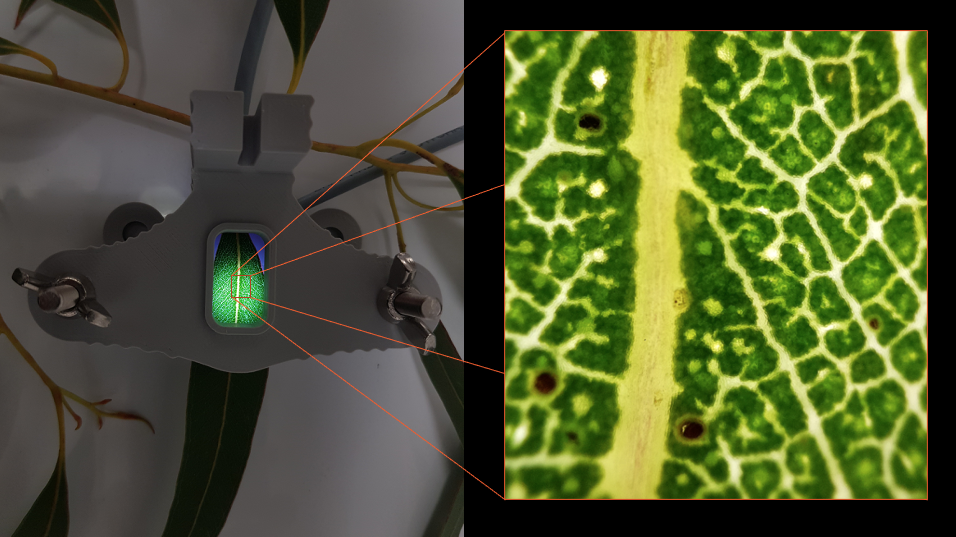Simple image processing techniques applied to images of plant xylem over time can reveal the formation of air embolisms (also known as cavitation), a key indicator of severe water stress in plants. Developed by Prof. Tim Brodribb and researchers at the University of Tasmania and the University Grenoble Alpes, the technique provides a simpler and more accurate method of evaluating drought stress and tolerance in plants compared to other approaches.

Originally developed to capture images for xylem cavitation imaging, the time-lapse camera integrates all the necessary components for the technique, including bright illumination, sample magnification and soft but secure clamping to reduce movement and damage. The shape and size of the device maximises light exposure and air ventilation.
Both stem and leaf xylem can be imaged.
Relevant Publications and More Information
More information on the technique can be found at https://opensourceov.org
Johnson, K. M., Lucani, C., & Brodribb, T. J. (2022). In vivo monitoring of drought-induced embolism in Callitris rhomboidea trees reveals wide variation in branchlet vulnerability and high resistance to tissue death. New Phytologist, 233(1), 207–218. https://doi.org/10.1111/nph.17786
Johnson, K. M., Brodersen, C., Carins-Murphy, M. R., Choat, B., & Brodribb, T. J. (2020). Xylem Embolism Spreads by Single-Conduit Events in Three Dry Forest Angiosperm Stems1[OPEN]. Plant Physiology, 184(1), 212–222. https://doi.org/10.1104/PP.20.00464
Sorek, Y., Grinshtein, S., Netzer, Y., Shtein, I., Jansen, S., & Hochberg, U. (2020). An increase in xylem embolism resistance of grapevine leaves during the growing season is coordinated with stomatal regulation, turgor loss point, and intervessel pit membranes. New Phytologist. https://doi.org/10.1111/nph.17025
Gauthey, A., Peters, J. M. R., Carins-Murphy, M. R., Rodriguez-Dominguez, C. M., Li, X., Delzon, S., … Choat, B. (2020). Visual and hydraulic techniques produce similar estimates of cavitation resistance in woody species. New Phytologist, 228(3), 884–897. https://doi.org/10.1111/nph.16746
Rodriguez-Dominguez CM, Carins Murphy MR, Lucani C, Brodribb TJ (2018) Mapping xylem failure in disparate organs of whole plants reveals extreme resistance in olive roots. New Phytologist.
Corso, D., Delzon, S., Lamarque, L. J., Cochard, H., Torres-Ruiz, J. M., King, A., & Brodribb, T. (2020). Neither xylem collapse, cavitation, or changing leaf conductance drive stomatal closure in wheat. Plant Cell and Environment, 43(4), 854–865. https://doi.org/10.1111/pce.13722
Cardoso, A. A., Visel, D., Kane, C. N., Batz, T. A., García Sánchez, C., Kaack, L., … McAdam, S. A. M. (2020). Drought-induced lacuna formation in the stem causes hydraulic conductance to decline before xylem embolism in Selaginella. New Phytologist, 227(6), 1804–1817. https://doi.org/10.1111/nph.16649
Suissa, J. S., & Friedman, W. E. (2021). From cells to stems: the effects of primary vascular construction on drought‐induced embolism in fern rhizomes. New Phytologist. https://doi.org/10.1111/nph.17629
Li, X., Blackman, C. J., Peters, J. M. R., Choat, B., Rymer, P. D., Medlyn, B. E., & Tissue, D. T. (2019). More than iso/anisohydry: Hydroscapes integrate plant water use and drought tolerance traits in 10 eucalypt species from contrasting climates. Functional Ecology, 33(6), 1035–1049. https://doi.org/10.1111/1365-2435.13320
Avila, R. T., Cardoso, A. A., Batz, T. A., Kane, C. N., DaMatta, F. M., & McAdam, S. A. M. (2021). Limited plasticity in embolism resistance in response to light in leaves and stems in species with considerable vulnerability segmentation. Physiologia Plantarum, 172(4), 2142–2152. https://doi.org/10.1111/ppl.13450
Guan, X., Pereira, L., McAdam, S., Cao, K.-F., & Jansen, S. (2020). No gas source, no problem: pre-existing embolism may affect non-pressure driven embolism spreading in angiosperm xylem by gas diffusion. Authorea Preprints, (410768178), 1–18. Retrieved from https://www.authorea.com/users/349270/articles/474338-no-gas-source-no-problem-pre-existing-embolism-may-affect-non-pressure-driven-embolism-spreading-in-angiosperm-xylem-by-gas-diffusion?commit=960742a1e2ffacc5494453d3ea5235fc0937b112